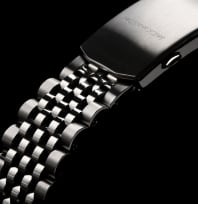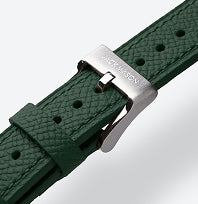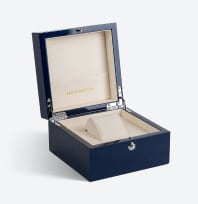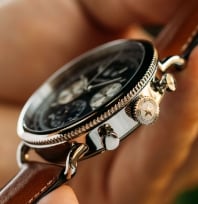The watch is the quintessential fashion item. Whether worn for purely functional purposes or used to elevate an outfit, the benefits of wearing a watch far outweigh the negligible-at-best downsides.
Whether one wants a refresher on how to wear their favorite accessory or gain an introduction to an article whose reputation for style and dignity precedes itself, Jack Mason is here to offer the ultimate guide on how to wear a watch.
Fundamentals
There are a few key elements that are absolutely essential to one's horological future. How do you properly wear a watch? How do you navigate the numerous types and movements?
And how do you figure out the proper watch size for your wrist?
How to Wear a Watch
One of the key rules to be aware of when wearing a watch is knowing which hand to wear it on. Most people wear their watch on their left hand. We say “most” for a reason: the non-dominant hand is the proper one on which to wear a watch. By wearing a watch on your off hand, you extend its lifespan and protect it from getting scratched in any of the myriad activities or exertions we use our dominant hand for.
Matching Your Watch to Your Outfit
Choosing when to wear your watch is just as important as where you wear it. True fashion etiquette has become less rigorously structured since the latter half of the 20th century, but there are still some axioms about wearing your watch that hold true.
Firstly, if you elect to wear a leather strap while also wearing leather shoes, both types of leather should match. This becomes easier to manage if you can find a watch with quick-release pins, which allow you to easily change and customize your strap to fit your outfit.
Secondly, if you have multiple metallic accents on your outfit, such as your belt buckle, shoe buckle, or cufflinks, you should endeavor, if possible, to match your case or band to the other metals.
Deciding Which Watch is Right for You
Now that you have had an introduction to rules to keep in mind when wearing your watch, it is time to take active steps in choosing an ideal watch. We will now be introducing the two key facets affecting both the aesthetic and practical functions of watches: Movement and type.
Movement refers to the mechanism powering the movable elements of a watch, whereas type refers to the overall functionality of a watch.
Watch Movements
There are three key types of watch movements: Mechanical, automatic, and quartz. Of these, mechanical is the oldest, followed by automatic, with quartz movement first appearing a scant 52 years ago.
Mechanical watch movements are defined by intricate, precise machinery and exquisite craftsmanship. These watches are powered by hand-wound springs and take daily maintenance. They often have partially clear case backs to exhibit the delicate machinery, which makes them appreciated by connoisseurs.
Automatic watch movements are actually a subcategory of mechanical watches, called automatic for their self-winding motors. The movement relies on the motion of the wrist, and for this reason, automatic watches were not successful until the popularization of wristwatches in the early 20th century. A rotor inside the watch rotates with movement, thus generating the power for the watch.
Automatic watches can still be hand wound however, as if they are not worn for a lengthy period of time the stored kinetic energy will deplete, and the watch will cease to function until it is wound or rotated once more. Automatic watches boast a heftier weight and increased size due to necessity than their mechanical and quartz counterparts. Both automatic and mechanical watches feature a constantly moving second hand, creating a beautiful legato, sweeping motion that they are appreciated for.
Quartz watch movements do not rely on mechanical parts like the previously listed movements do. Instead, a battery sends carefully measured bursts of electricity to a quartz crystal, which vibrates in precise measurements. Quartz watches tend to be more accurate but generally lack the fine, consistent sweeping motion. Instead, they create a staccato “tick tick” movement.
Watch Types
In truth, there are enough watch types to merit an article dedicated solely to them. But, for a general guide, we are going to briefly cover a few of the most common types.
Dress watches feature elegant designs and are meant to be appropriate under all formal situations. Though dress watches can be worn with casual attire, it is important for a dress watch to be smaller so that it can fit under long-sleeved shirts without bulging or bunching.
Field watches were originally developed for combat use, and this shows in their modern design. Practical, legible, stylish, and rugged: field watches make for the perfect all-terrain watch, no matter the occasion.
Closely related are pilot watches, simple timepieces that feature larger dials and hands for maximum legibility. They also often are built to be more shock and water-resistant than other watches.
Racing watches come packed with a massive array of complications, including chronographs, and for this reason, they tend to be larger than other watches.
Diver’s watches were developed in tandem with modern scuba equipment and are built to be more water-resistant as well as highly legible. Cinephiles may enjoy knowing that James Bond, in his current incarnation, often wears diver’s watches.
Sizing Yourself for Your Watch
By now, you have received general style tips and been given an introduction to both watch movements and types. Only one step remains before you go forth and accessorize confidently: Measuring your wrist in order to discover your ideal watch size.
There are two easy ways to measure the size of your wrist. The first is to wrap a tape measure around your wrist and take the measurement that way. If you do not have a tape measure handy, there is a simpler, albeit less precise method, to take your measurement. By wrapping a dollar bill, which is six inches long, around your wrist, you can estimate by the amount of coverage it gives you what your wrist size is. Following our guide, wrist sizing works roughly like this:
- 6 inches: Cases around 34mm - 38mm.
- 7 to 7.5 inches: Cases around 39mm, 40mm, and 42mm.
- 8 inches and larger: Cases between 44-46mm, or even 47mm.
Additionally, we recommend the following dimensions for band size:
- 6.0 - 6.5” wrist or 150 - 164mm = 120/70mm
- 6.6 - 7.0” wrist or 165 - 178mm = 125/75mm
- 7.1 - 7.5” wrist or 179 - 190mm = 130/80mm
- 7.6 - 8.0” wrist or 191 - 203mm = 135/80mm
- 8.1 - 8.5” wrist or 204 - 216mm = 140/85mm
- 8.6 - 9.0” wrist or 217 - 229mm = 145/90mm
Navigating Watch Hazards
Even for the most cautious of individuals, life happens. For that reason, these next few sections will discuss the most deadly dangers your watch may face on a semi-regular basis. After this, you will be fully equipped to find a watch you love and to wear and take care of it to the best of your ability.
Magnetism
A disclaimer: Magnetism is primarily an issue with mechanical and automatic watch movements, as quartz watches have components protecting them from the effect of magnetism. Many objects in daily life are magnetic to a small degree: Cell phones, tablets, radios, and other tech. Magnetism in small doses should pose no issue to a watch.
However, sometimes when a watch is exposed to a high degree of magnetism, the internal machinery can become magnetized, which translates to seconds or minutes gained or lost every day. The fix in cases like this is fortunately simple: Either take your watch to a local watchmaker, or else you can purchase a demagnetizer online.
If you are unsure whether or not your watch has been magnetized, you can try holding it above a compass. If the needle of the compass moves as the watch approaches it, then your watch has been magnetized and needs readjusting.
Beware of Water
Water can spell demise for any kind of watch. Aside from diver’s watches, timepieces are largely not designed for use in water, merely to survive being used in water. When purchasing a watch, the depth of water resistance is listed, usually measured in meters. The most common water testing depth is 100 meters, though divers watches can be tested much deeper. This does not mean you can be totally carefree at the pool, however.
The depth test measures the amount of water pressure the protective gasket of the watch can withstand, and abrupt changes in pressure such as those caused by jumping off a diving board into a pool repeatedly can strain the gasket and cause water to leak into the watch. Additionally, adjusting the crown or other components of the watch underwater may temporarily break the seal created by the gasket. Neither the electronic components of quartz watches nor the machine components found in mechanical and automatic watches are water-proof, but with proper caution, water should prove no issue for your timepiece.
You should also be wary of your watch band: Leather and some metals may be damaged by water, so for this reason, we recommend keeping these bands far away from the beach or pool. If they do get wet, immediately wipe them off to minimize damage.
Keeping Time in Check
Ultimately, the best watch for you is one you feel comfortable and confident in. Watches can be dressed up or dressed down, and there’s a watch for every hobby, event, and lifestyle.
With careful love and treatment, your watch should keep ticking as long as you do.
Sources:
The Five Main Watch Types… | Wristworthy
Tom Ford Interview: The Rules to Wearing a Watch | British GQ









